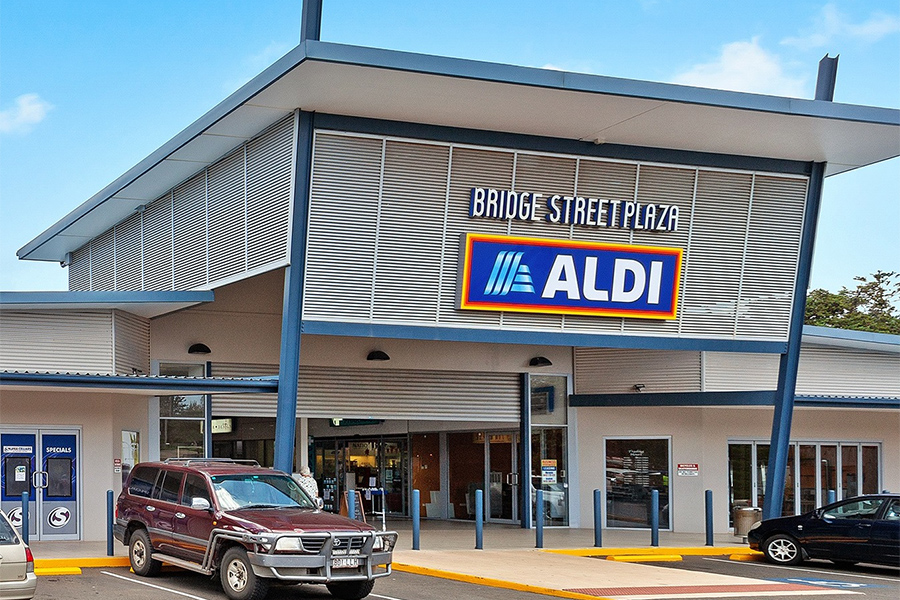See John Schroder speaking at the Big Guns lunch – video below
Finding new mountains to climb
The funny thing about the ‘tectonic shifts’ we’re seeing in retail is that, by definition, the plates keep moving and the landscape is always changing. The upside is that we’ll always have new mountains to climb and one thing is certain: it’s never boring. So, let’s consider some of the prime movers for the latest seismic shifts in retail.
Global disruption is the new norm and, as previously predicted, we’re continuing to see more new internationals entering the Australian market. H&M is expanding rapidly; Zara and Zara Home are trading muy bien; Aldi has already succeeded in creating a credible and highly successful third force in supermarkets, and a long list of other brands are finding local success with imported business models.
Meanwhile, Woolworths South Africa is doing a masterful job turning the DJs ocean liner towards calmer seas and warmer climes. Also out of South Africa, we’re seeing Pepkor carve out a lucrative niche in affordable homewares, manchester and clothing through its Harris Scarfe and Best&Less brands. Its compatriot, MRP, is the latest big South African to migrate to our shores, which brings me to my next point.
Like Zara and H&M, Mr Price started in clothing (in its case in 1885) when Australia was still in short pants, but just before the end of its second century in business and the turn of the new millennium (1998), Mr Price Home was born, which now goes by the abbreviated moniker MRP. The immutable fact is that more retailers are cottoning on (no pun intended) to the idea that home is where Australian customers’ hearts are. In recent years we’ve seen the rise and rise of specialties such as My House, Adairs and Bed Bath N’ Table. Kmart, Big W and Target have also increased their focus on all things homewares. US stalwart Williams Sonoma, and its various subsidiary brands such as Pottery Barn, is one of the latest retailers to capitalise on Australians’ obsession with all things New Hamptons, rustic or distressed (and preferably all three). JB Hi-Fi Home is the latest retailer vying for a greater share of the wallet by focusing on the insight that technophiles have homes too, as it taps the irresistible cross-selling opportunity for various other forms of domestic gadgetry.
Another new mega trend sees the big guys getting smaller and the small guys getting bigger.
Department stores and discount department stores are accountable to the bean counters for every square metre they occupy, and that space has gotta pay. David Jones seems set to sell, consolidate and lease back space in its Elizabeth Street and Market Street stores in the Sydney CBD. An excellent example of the new, leaner DJs will come to fruition at our $372-million redevelopment and expansion of Stockland Green Hills.
DJs will open a new, single-level, 6,225m2 department store focused on what it believes it can do best in the trade area. Given the context of a single-level department store, customers can expect to see and experience a more highly refined curation of products and seasonal styles. If you’re interested in seeing the reinvention of DJs, take a look at its store at Eastland in Melbourne – it’s fabulous!
If you’ve ever looked at an old newspaper archive from early last century, the page layout shares similar attributes to how department stores in Australia used to look; crowded with detail and with virtually no white space separating the lines. Department stores have evolved more in the last decade than they have in the last century, and they’ve realised that less in store is more. Like newspapers, department stores have de-cluttered their layout.
At Stockland Green Hills, in an unwritten yet symbiotic relationship, JB Hi-Fi Home will set up shop on the lower level beneath DJs. Amongst JB’s mobile phones, tablets, laptops, cameras, printers and games, customers can expect to find discount whitegoods and other home appliances such as coffee machines, Nutri-Bullets and the like that would have traditionally been the exclusive province of an old-school department store. Harris Scarfe Home will also open at Green Hills, adding its unique style to the choice of homewares and soft furnishings on offer to customers.
In this new age of ‘rationalised’ store footprints, supermarkets are the exception to the rule, where bigger is generally better – and noone is better than Coles and Woolworths when it comes to maximising the productivity of every square metre of GLA. The exception to the rule is Aldi, which is generating high levels of productivity from comparatively smaller footprints.
Conversely, specialties are getting bigger as they expand and diversify to carry more product lines. Bardot and Witchery are excellent examples of this emergent trend. Both once focused exclusively on ladies’ apparel; however, Bardot now carries a wide range of accessories in store, including jewellery, shoes, bags, belts, scarves, hats and sunglasses. It’s also branched into children’s wear with Bardot Junior. Likewise, Witchery is expanding to widen its appeal beyond la femme to find new customers amongst fashion-conscious men, girls and boys.
With the big and the small ends of town meeting somewhere in the middle, we’re seeing the increasing democratisation of retail when it comes to customer pulling power. Twenty years ago, you weren’t in the main game without a department store, but we now have the latitude and retail palette to create and curate destinations based on a far more intricate and complex retail mix, and far more sophisticated, less homogenous customers who expect modern malls to cater to a wider range of tastes and senses.
We gained first-hand experience of the changing face of retail when we designed, developed and opened the second stage of our $228-million redevelopment of Stockland Wetherill Park in December 2015, three months ahead of schedule. Here we have a 12-screen Hoyts, JB Hi-Fi Home, Fit n’ Fast gym, Target, Big W and, of course, Woolworths and Coles – but the all-pervasive, decentralised anchor is food.
The customer experience at Wetherill Park is defined by fresh food and fast casual dining, with a modern twist on laneway-style street food vendors and a new 800-seat indoor-outdoor casual dining precinct. ‘The Grove’ features 14 new restaurants, cafés and food operators including Fogo Brazillia, Mashita Sushi, Soul Origin, Le Wrap, Subway and Top Juice. In fact, we’ve more than doubled our fresh food and casual dining offering throughout the centre, with over 21% of the retail mix focused on food, including Nandos, Grill’d, San Churro, Thai Rock, Rashay’s Pizza Pasta and Grill and the first Jamie’s Ministry of Food in NSW.
Customers’ response to the ‘new’ Wetherill Park has been phenomenal, and I’ve never seen anything like it. We’re used to experiencing a period of stabilisation as customers reorientate themselves with the new retail offer, and it’s not unusual for any major expansion to see a slight dilution of trade. However, at Wetherill Park, our ‘food as anchor’ strategy has lifted the performance of the entire centre. We’ve almost doubled the number of specialty retailers and achieved growth in productivity per square metre of GLA.
It’s often said that parks and green spaces are the lungs that allow a city to breathe. With the increasing urbanisation and densification of our metropolitan areas, well-considered shopping centres are playing an increasingly important role as leisure, relaxation, entertainment and dining destinations, with an expectation for fabulous, rather than simply fast, food. All of us in the industry are well aware of the changing persona of retail, and we’re all acting to make our retail environments more enticing and exciting.
We’re also helping to market and grow demand for a whole range of other services that, previously, would have been found on the high street or in ‘non-retail’ locations.
In the years since the GFC, we saw the rise of ‘affordable luxuries’ in retail: nail salons, massage clinics and day spas, and the ‘growth’ of bearded baristas and the now-ubiquitous café culture. In recent years, we’ve seen the proliferation of the trend for tantalising treats give rise to the likes of San Churro, Max Brenner and a host of new specialty dessert bars.
The latest businesses to come in from the cold, or to step out of the heat and humidity of Central and Far North Queensland, are retail services, with a particular emphasis on health, wellbeing, personal grooming and financial services. We’re currently charting the rise of hipster barbers, complete with specialist beard-trimming services, teeth-whitening pop-up bars and laser clinics.
Australians are living longer, but they have less time and are less willing to run all over town. Customers want and expect greater convenience, which means they want to visit their dentist, doctor, physio, acupuncturist, audiologist or optometrist in one place, in air-conditioned comfort, with easy parking.
And with Australians living longer, they want to look better. A few years ago, retirees were all blue rinse, dentures, floral house frocks and afternoon naps, but these days, after seniors have had their porcelain teeth repolished, nails and hair done and tan topped up, you’re likely to find them hitting the in-centre gym in their latest active wear to tone up ahead of their next luxury pan-Pacific cruise.
Finally, back to the future. What are the soothsayers saying about the latest digital or ‘phygital’ retail trends?
International point-of-sale technology specialist, Vend HQ, points to ‘mobile playing a bigger role in click-and-collect initiatives’. Vend says Nordstrom is testing a service that allows the customer to call or text the retail employee as they approach the store, so the customer doesn’t even have to get out of their car.
The same blog also cites MasterCard research, which found that “eight out of 10 consumers now use a computer, smartphone, tablet, or in-store technology while shopping.” Speak to any retailer and they’ll tell you that customers’ use of mobile devices for in-store price comparison used to be done surreptitiously, but now it’s far more brazen and ‘in your face’. The net result is that more retailers will adopt in-store mobile devices for staff for more nimble price competitiveness, but also to enable more fluid and mobile transaction processing and improved customer service.
In another blog, Jim Holbrook, CEO of US-based Damon Worldwide, writes of a bright future for bricks-and-mortar retail as “consumers counteract technology overload and unlimited media content by increasingly looking for balance. They are plugging into their lives, experiences and moments – not only their devices [which is refreshing]. It’s becoming increasingly popular to focus on extremes; for example, spending a Saturday watching a 12-hour TV marathon and then running an actual marathon on Sunday. Retailers have recognised this shift [with Lorna Jane and Rebel profiting from the fact that many people will do all of the above in their ‘active wear’]. Retailers are delivering on the desire for balance – as seen in the rise of indulgent mini-desserts and bite-sized comfort foods – and creating programs and promotions tailored to consumers’ extreme lifestyles.” And after that little indulgence, that same customer, like the rest of us in retail, will no doubt be searching for new mountains to climb.




















